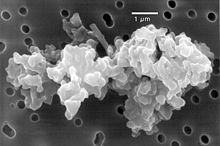
Back Ruimtestof Afrikaans غبار كوني Arabic Polvu cósmico AST Космос саңы Bashkir Касмічны пыл Byelorussian Касьмічны пыл BE-X-OLD Космически прах Bulgarian মহাজাগতিক ধূলিকণা Bengali/Bangla Svemirska prašina BS Pols còsmica Catalan

Cosmic dust – also called extraterrestrial dust, space dust, or star dust – is dust that occurs in outer space or has fallen onto Earth.[1][2] Most cosmic dust particles measure between a few molecules and 0.1 mm (100 μm), such as micrometeoroids (<30 μm) and meteoroids (>30 μm).[3] Cosmic dust can be further distinguished by its astronomical location: intergalactic dust, interstellar dust, interplanetary dust (as in the zodiacal cloud), and circumplanetary dust (as in a planetary ring). There are several methods to obtain space dust measurement.
In the Solar System, interplanetary dust causes the zodiacal light. Solar System dust includes comet dust, planetary dust (like from Mars),[4] asteroidal dust, dust from the Kuiper belt, and interstellar dust passing through the Solar System. Thousands of tons of cosmic dust are estimated to reach Earth's surface every year,[5] with most grains having a mass between 10−16 kg (0.1 pg) and 10−4 kg (0.1 g).[5] The density of the dust cloud through which the Earth is traveling is approximately 10−6 dust grains/m3.[6]
Cosmic dust contains some complex organic compounds (amorphous organic solids with a mixed aromatic–aliphatic structure) that could be created naturally, and rapidly, by stars.[7][8][9] A smaller fraction of dust in space is "stardust" consisting of larger refractory minerals that condensed as matter left by stars.
Interstellar dust particles were collected by the Stardust spacecraft and samples were returned to Earth in 2006.[10][11][12][13]
- ^ Broad, William J. (March 10, 2017). "Flecks of Extraterrestrial Dust, All Over the Roof". The New York Times. Retrieved 2017-03-10.
- ^ Gengel, M. J.; Larsen, J.; Van Ginneken, M.; Suttle, M. D. (December 1, 2016). "An urban collection of modern-day large micrometeorites: Evidence for variations in the extraterrestrial dust flux through the Quaternary". Geology. 45 (2): 119. Bibcode:2017Geo....45..119G. doi:10.1130/G38352.1. hdl:10044/1/42484.
- ^ "International Astronomical Union | IAU".
- ^ Shekhtman, Svetlana (2021-03-08). "Serendipitous Juno Detections Shatter Ideas About Zodiacal Light". NASA. Retrieved 2023-01-21.
- ^ a b Zook, Herbert A. (2001). "Spacecraft Measurements of the Cosmic Dust Flux". Accretion of Extraterrestrial Matter Throughout Earth's History. pp. 75–92. doi:10.1007/978-1-4419-8694-8_5. ISBN 978-1-4613-4668-5.
- ^ Matloff, Gregory L.; Johnson, Less (February 2005). "Applications of the Electrodynamic Tether to Interstellar Travel" (PDF).
- ^ Chow, Denise (26 October 2011). "Discovery: Cosmic Dust Contains Organic Matter from Stars". Space.com. Retrieved 2011-10-26.
- ^ ScienceDaily Staff (26 October 2011). "Astronomers Discover Complex Organic Matter Exists Throughout the Universe". ScienceDaily. Retrieved 2011-10-27.
- ^ Kwok, Sun; Zhang, Yong (26 October 2011). "Mixed aromatic–aliphatic organic nanoparticles as carriers of unidentified infrared emission features". Nature. 479 (7371): 80–3. Bibcode:2011Natur.479...80K. doi:10.1038/nature10542. PMID 22031328. S2CID 4419859.
- ^ Agle, DC; Brown, Dwayne; Jeffs, William (August 14, 2014). "Stardust Discovers Potential Interstellar Space Particles". NASA. Retrieved August 14, 2014.
- ^ Dunn, Marcia (August 14, 2014). "Specks returned from space may be alien visitors". AP News. Archived from the original on August 19, 2014. Retrieved August 14, 2014.
- ^ Hand, Eric (August 14, 2014). "Seven grains of interstellar dust reveal their secrets". Science News. Retrieved August 14, 2014.
- ^ Westphal, Andrew J.; et al. (August 15, 2014). "Evidence for interstellar origin of seven dust particles collected by the Stardust spacecraft". Science. 345 (6198): 786–791. Bibcode:2014Sci...345..786W. doi:10.1126/science.1252496. hdl:2381/32470. PMID 25124433. S2CID 206556225.